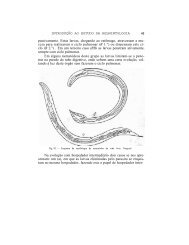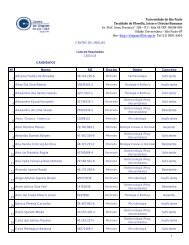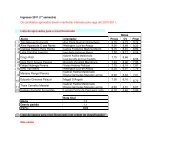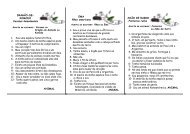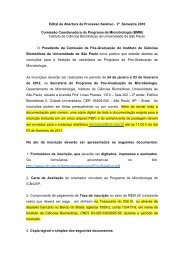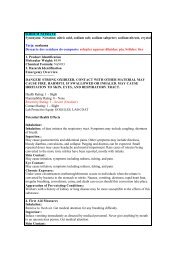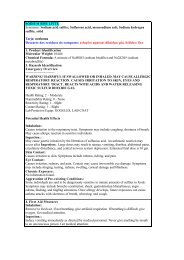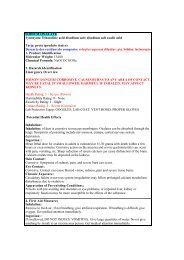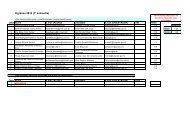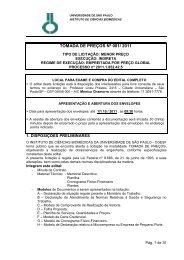Infected Human Erythrocytes
Infected Human Erythrocytes
Infected Human Erythrocytes
- No tags were found...
You also want an ePaper? Increase the reach of your titles
YUMPU automatically turns print PDFs into web optimized ePapers that Google loves.
50 Cell 134, 48–61, July 11, 2008 ª2008 Elsevier Inc.
Figure 3. Essentiality of Genes in P. falciparum(A) Comparison of essentiality for genes judged byability to genetically disrupt them. Comparison isshown for all genes (Overall), the exported andPEXEL containing proteins (Exported/PEXEL)and those not exported (non-PEXEL). Unsuccessfuldisruptions are in gray while successful onesare in green.(B) Comparison of non-essential proteins to thosenot disrupted. The proteins are divided into hypothetical(blue), annotated (red) and those assignedto a metabolic pathway (white) (PlasmoDB, www.plasmodb.org).(C) Essentiality of different gene groups. The essentialityof the genes was compared with respectto transcription profile, homologies, chromosomalposition and allelic variability. The bars show essentiality(as determined by the percentage of unsuccessfulgene knock-outs for each group) of exported(red) and non-exported gene products(yellow). n = number of attempted gene disruptionfor exported (red) and non-exported proteins (yellow)in each group.(D) The essentiality of gene families as shown bythe ability to generate a genetic disruption. n =number of attempted gene disruption/total membersin gene family. PEXEL-containing familiesare shown in red and non-PEXEL families are depictedin yellow.Four of the mutant cell lines, in which the genes PFB0106c,MAL7P1.172, PF13_0076 and PF14_0758 had been disrupted,showed none or very low levels of surface expressed PfEMP1as evidenced by the absence of cleaved fragments of any size.The CS2DMAL7P1.172 cells also showed greatly reduced levelsof total PfEMP1. The parasite lines CS2DMAL7P1.171 andCS2DPF10_0025 showed consistently reduced surface expressionof PfEMP1, in multiple independent experiments, incomparison with parental wild-type cells. These results suggestthat proteins encoded by PFB0106c, MAL7P1.172,PF13_0076, PF14_0758, MAL7P1.171 and PF10_0025 playa role in trafficking and display of the virulenceprotein PfEMP1 on the host erythrocyte(Figure 7).Although the expression of the var2csagene is very stable in comparison to othermembers of the var gene family, switchingto other var genes does occur at lowfrequency and these other var gene productswould not react with the sera that weused. In order to eliminate such false positives,we screened all knockout parasitesfor their ability to bind to CSA, which isa unique feature of the var2sa gene product.Four parasite lines CS2DPFA0620c,CS2DPFB0090c, CS2DPFE0060w andCS2DMAL7P1.91 showed decreasedlevels of adherence to CSA and a trypsincleavedC terminus of PfEMP1 of altered size suggesting a switchto an alternative PfEMP1-encoding gene. These lines were subjectedto selection for CSA binding to recover parasites in whichvar2csa was the dominant var gene expressed. Following selection,an increased reactivity with human serum from multigravidfemales compared to unselected lines was observed (Figure 4APFA0620c up, PFB0090c up, PFE0060w up). Additionally, thesize of the trypsin-cleaved PfEMP1 was now the same as theparental CS2 line (Fig. S3 compared to before CSA selectionFigure 4C). We conclude that these lines are false positives dueto antigenic switching.52 Cell 134, 48–61, July 11, 2008 ª2008 Elsevier Inc.
54 Cell 134, 48–61, July 11, 2008 ª2008 Elsevier Inc.
Figure 5. Microscopic Analysis of Mutants with Export Defects(A) Localization of PfEMP1 and KAHRP in mutant P. falciparum-infected erythrocytes. The parasite lines shown are those with either no PfEMP1 or reduced levelson the surface of infected erythrocytes determined by FACS and trypsin analysis. The first panel depicts localization of PfEMP1 and the second panel showslocalization of KAHRP. The first column of each panel shows a bright-field image, the second panel specific antibody (either anti-PfEMP1 or anti-KAHRP) andthe third panel overlay of the previous two and a nuclear stain (DAPI).(B) Localization pattern of three proteins which when deleted ablate surface exposure of PfEMP1. These proteins were detected with specific antibodies raisedagainst the gene products of PFB0106c, MAL7P1.172 and PF14_0758 (see Figure 2C). The first panel shows a bright-field image, followed by a DAPI image, thenthe specific antibody (green), then antibodies against the Maurer’s cleft resident protein SBP1 (red) and an overlay of the specific antibody with SBP1 localization.(C) Localization of PfEMP1 (first panel) and KAHRP (second panel) for parasite lines CS2DPF10_0381 and CS2DPFD1170c. Shown are a brightfield image, specificantibody (either anti-PfEMP1 or anti-KAHRP) and an overlay of the two with a nuclear stain (DAPI).(D) Scanning electron microscopy of CS2DPF10_0381 and CS2DPFD1170c infected erythrocytes. The first panel shows parental CS2-infected erythrocytes withnormal knobs compared to the two mutant lines in which knobs are absent (PFD1170c) or greatly reduced in size (PF10_0381). The scale bar represents 2 mm.a phenotype similar to that observed for KAHRP disruption(Crabb et al., 1997) (Figure 4C) and suggesting the proteinsencoded by these genes are required for correct assembly ofKAHRP into knobs (Figures 6D and 7). Interestingly, whenP. falciparum isolates with different adhesion properties werecompared in a proteomic analysis, PFD1170c was identified asbeing expressed at 3-fold increased levels in the membrane ofinfected erythrocytes of different strains (Florens et al., 2004).In light of our results, it is plausible that the increased expressionof the PFD1170c protein results in a higher density of knob structuresand therefore increased adherence.An interesting family of proteins that are exported in P. falciparumare the DnaJ proteins and these are likely to function as cochaperoneswith HSP70 to fold and assemble protein structureswithin the parasite-infected erythrocyte. Eleven of these werenot essential for in vitro growth and are likely to be involved inoverlapping functions. Interestingly, three of the genes withDnaJ domains could not be disrupted and presumably are involvedin essential functions. One is a DnaJ type I protein andconserved across all Plasmodium spp. and is likely to be requiredas a cochaperone for a conserved set of protein(s). ThePF10_0381 protein has a DnaJ domain and is classified asHSP40-like, providing a clue to its function in knob assembly(Figure 6D). Recently, it has been suggested that the type III classof Hsp40 proteins should be divided into a new type IV class thatexhibit variations in the HDP catalytic motif within the conservedJ domain (Botha et al., 2007) and PF10_0381 can be classified inthis group. In general Hsp40 proteins can serve two roles; first,targeting protein substrates to Hsp70 for folding and second,stabilization of Hsp70 in a substrate-bound form. However, as56 Cell 134, 48–61, July 11, 2008 ª2008 Elsevier Inc.
Figure 6. Genes Involved in P. falciparum-<strong>Infected</strong> Erythrocyte Rigidity and Properties of Proteins that Play a Role in Trafficking or Functionof PfEMP1(A) Rigidity as measured using the LORCA for all generated mutants compared to CS2. The four highest shear stress points (see Figure 5B) for each cell line wasused to calculate the deformability ratio and compared to the ratio of CS2.(B) Examples of LORCA measurements comparing membrane rigidity of P. falciparum-infected erythrocytes. The erythrocyte rigidity (expressed as elongationindex [EI]) conferred on the host cell by each mutant P. falciparum line (green) compared to parent CS2 (blue) and uninfected red cells (red) at increasing shearstress measured in pascal (Pa). Parasites were synchronised and concentrated to 40% parasitaemia to increase sensitivity of the measurement. Error barsindicate standard deviation.(C) Structure of the proteins that play a role in trafficking and function of PfEMP1. The gene number is shown for each protein from PlasmoDB (www.plasmodb).Yellow refers to a proposed signal sequence while red signifies the presence of a PEXEL required for export. Black shading corresponds to a proposedtransmembrane region. Green refers to a DnaJ domain and blue a TIGRFAM01639 domain.(D) Diagrammatic representation of a P. falciparum-infected erythrocyte signifying the localization of the protein (green symbols) or their functional position withrespect to effects on PfEMP1 trafficking when disrupted (yellow letters).yet type III and IV Hsp40 proteins have not been shown to bindpolypeptide substrates and it has been suggested they maynot have chaperone activity. They may serve a specialized rolein recruitment of Hsp70 for folding of specific substrates andPF10_0381 may play a direct role in assembly of KAHRP withinknob structures.Severe malaria caused by P. falciparum can involve multipleorgan failure and this is associated with increased rigidity of parasite-infectederythrocytes that can contribute to blockage ofmicro-capillaries (Nash et al., 1989). Normal erythrocytes arehighly deformable allowing them to flow through the smallestcapillaries and this property is due to their low internal viscosity,high-surface-area to volume ratio, and the elastic nature of theerythrocyte membrane and underlying cytoskeleton. As theP. falciparum parasite grows within the erythrocyte it loses its deformabilityand becomes spherocytic and more rigid (CookeCell 134, 48–61, July 11, 2008 ª2008 Elsevier Inc. 57
Figure 7. Function and Properties of Selected Proteins Identified by the P. falciparum Gene Knockout ScreenThese proteins play a role in function or trafficking of the major virulence protein PfEMP1 or a putative role in determination of rigidity. The full description of thegenes and proteins can be found at http://plasmodb.org/. Most proteins have a PEXEL, which is required for export to the infected erythrocyte. Changes in rigidityconferred on the host cell by each mutant P. falciparum line was compared to parent CS2 and uninfected red cells at increasing shear stress and are relative toCS2-infected erythrocytes. Those shown as a positive number have a significantly increased rigidity whilst those that are negative have a decrease in rigidity thatis more than the CS2DPFA0110w (RESA) parasite line that has been shown previously to have an altered rigidity (Silva et al., 2005). The TIGR FAM01639 domain inMAL7P1.172 represents a conserved sequence of about 60 amino acids found in over 40 predicted proteins of P. falciparum. It is not found elsewhere, includingclosely related species such as P. yoelii. The PHIST proteins share a homologous domain unique to Plasmodium of 150 amino acids and have been divided intoa number of subfamilies (a, b, and c) (Sargeant et al., 2006). The skeleton binding protein 1 is included as a reference protein that is involved in PfEMP1 trafficking(Maier et al., 2007; Cooke et al., 2006).et al., 2004). These properties are thought to contribute to thepathogenesis of malaria, in addition to vascular adhesion of parasitisederythrocytes. The altered deformability is manifested byexport of proteins into erythrocytes that interact with the host cellcytoskeleton and insert into the membrane. Using micro-pipettingtechniques it has been shown KAHRP and PfEMP3 contributeto altered membrane rigidity of P. falciparum-infected erythrocytes(Cooke et al., 2006). In this study, it was not possible touse micropipetting methods on such a large number of mutantcell lines and we therefore used LORCA, which has alloweda higher throughput analysis (Hardeman et al., 1998). However,the LORCA has disadvantages in that the sensitivity is not thesame as micro-pipetting and as a result we may have missedidentifying some mutant lines with rigidity phenotypes. Nevertheless,it was clear that a number of mutant cell lines had alterederythrocyte rigidity compared to the parental line, suggestingthat a large number of exported proteins contribute to the overallrigidity of the erythrocyte.It is interesting that in S. cerevisiae 19% of genes are essentialand under experimental conditions the functions of most are notrequired (Giaever et al., 2002). In P. falciparum, at least for thegene set we have chosen, 36% appeared to be essential suggestingthat there may be less redundancy in function for thisprotozoan parasite (Figure 3A). However, this figure may besomewhat high due to the fact that genetic tools in this parasiteare not as well developed and therefore efficiency of targetingmay be less optimal (Maier et al., 2006). However, it is clearthat the genes encoding exported proteins are generally dispensablefor in vitro growth with only 23.5% of these apparentlyessential using current genetic tools.The exported proteome is predicted to comprise 455 proteins(8% of the genome) and of these, 256 code for the variant proteinsPfEMP1 (59), stevor (32) and rifins (165) (Sargeant et al.,2006). The remaining 199 consist of unique genes and a numberof gene families that, for example, encode proteins that havea DnaJ or a PHIST domain. The reasons for the greatly expanded58 Cell 134, 48–61, July 11, 2008 ª2008 Elsevier Inc.
exported proteome in P. falciparum are not clear, however, thisorganism is unique in its expression of PfEMP1. We have suggestedpreviously that a proportion of the exported proteinswould be required for trafficking and function of this complexprotein (Sargeant et al., 2006). Consistent with this hypothesisis the identification of eight genes that encode proteins involvedin either PfEMP1 function or act as ancillary proteins required forassembly of knobs. It is likely that there will be other genes involvedin these functions that are yet to be identified. Additionally,many proteins may have overlapping functions and this redundancywould not be detected in our gene knockout screen.A core set of 36 exported proteins has been defined that areconserved in the genus Plasmodium, i.e., they can be found inat least two Plasmodium species (Sargeant et al., 2006). Wewere able to disrupt 7 out of 9 attempted core set genes, all ofwhich are specific to the primate lineage (Figure 3D). One exceptionis PFD0495c, which is one of only two core molecules whereorthologs can be found in all primate and mouse malaria parasitesexamined (Sargeant et al., 2006). The fact that a majorityof this core set is dispensable is rather surprising, since a broaderdistribution of genes within the genus could implicate a morefundamental importance. Interestingly, three of the gene deletionsresulted in PfEMP1 transport defects (MAL7P1.172,PF10_0025 and PF13_0076). Since PfEMP1 does not have anyorthologs in most other Plasmodium species the proteins encodedby these genes are likely to be involved in traffickingand export of a number of proteins.In summary, we have used a gene knockout approach ona scale not previously attempted in this organism to addressthe role of P. falciparum proteins that are exported into the parasite-infectederythrocyte. Collectively these proteins act like thesecretion systems seen in bacteria in which pathogenicity arisesfrom secreted proteins that interact with host cells by direct injectionor by their presence in the extracellular milieu (Abdallahet al., 2007). The complexity of the secreted protein repertoireand the number of membranes that must be crossed make thePlasmodium secretion system more comparable to secretionsystems of Gram negative bacteria (Christie et al., 2005; Cornelisand Van Gijsegem, 2000), however they appear significantlymore complex due to the reconstitution of a protein traffickingsystem within the red cell and involvement of multiple chaperonemolecules. Although it may not be worthwhile labeling them as aType VIII secretion system, it may be valuable to adopt approachesbeing tested in bacteria in which these systems arethe target of new therapeutic approaches aimed at minimizingpathogen virulence (Cegelski et al., 2008). This study significantlyextends our understanding the role of exported proteinsin host/parasite interactions essential for survival of P. falciparumin vivo and defines a group of potentially novel therapeutictargets.EXPERIMENTAL PROCEDURESCulture, Parasite Strains, Plasmid Constructs and ImmunoblotsCS2 wild-type parasites, a clone of the It isolate, adheres to chondroitin sulfateA (CSA) and hyaluronic acid in vitro. Constructs were assembled in pHHT-TK(Duraisingh et al., 2002) or pCC1 (Maier et al., 2006) and transfected as described(Crabb et al., 1997). To generate antibodies either GST-fusion proteinsor KLH-coupled fusion peptides were synthesized (Invitrogen) and injectedinto rabbits and IgG purified. Immunoblots were performed as described(Maier et al., 2007).Adherence and Trypsin Cleavage AssaysAdherence assays under static and flow conditions to CSA were performedusing P. falciparum –infected erythrocytes at 3% parasitemia and 1% hematocrit(Crabb et al., 1997). For trypsin cleavage, trophozoite stage parasiteswere either incubated in TPCK-treated trypsin (Sigma) (1 mg/ml in PBS), inPBS alone or in trypsin plus soybean trypsin inhibitor (5 mg/ml in PBS,Worthington, Lakewood, NJ, USA) at 37 C for 1 hr and analyzed as described(Waterkeyn et al., 2000).Laser-Assisted Optical Rotational Cell AnalysisTo measure deformability the infected red cells were analyzed via a laserassistedoptical rotational cell analyzer (LORCA). Two independent measurementswere taken and repeated in independent experiments. Each experimentincluded measurement of CS2 cultured in an identical red cell batch anduninfected erythrocytes (see supplementary procedures).Electron Microscopy and Immunofluorescence MicroscopyFor scanning electron microscopy parasite-infected red blood cells weretightly synchronised and processed as described (Rug et al., 2006). For immunofluoresenceanalysis, acetone/methanol (90%/10%) fixed smears of asynchronousparasites of CS2D- and/or CS2WT-infected erythrocytes wereprobed with rabbit anti-ATS (1:50), preabsorbed mouse anti-ATS (1:50), rabbitanti-KAHRP (1:200), mouse anti-KAHRP (His; 1:50), rabbit anti-SBP1 (1:500),mouse anti-SBP1 (1:500), mouse anti-PfEMP3 (1:2000), rabbit anti-PfEMP3(1:1000), rabbit anti-PF14_0758 (1:125), rabbit anti-MAL7P1.172 (1:250),rabbit anti-PFB0106c (1:50) and consequently incubated with Alexa Fluor488 conjugated anti-rabbit IgG (Molecular Probes) and Alexa Fluor 488 conjugatedanti-mouse IgG (Molecular Probes). See Supplemental ExperimentalProcedures for more detail.Antibodies to the Surface of P. falciparum <strong>Infected</strong> <strong>Erythrocytes</strong>Serum samples were tested for IgG binding to the surface of trophozoiteinfectederythrocytes at 3%–4% parasitemia, 0.2% hematocrit, using flowcytometry, as described (Beeson et al., 2006). All samples were tested induplicate. Sera were collected from malaria-exposed pregnant residents ofMadang Province, Papua New Guinea, presenting for routine antenatal careat the Modilon Hospital, Madang (Beeson et al., 2007). Written informed consentwas given by donors and ethical clearance obtained from the MedicalResearch Advisory Committee, Department of Health, PNG, and Walter andEliza Hall Institute Ethics Committee. Serum samples collected fromMelbourne residents were used as controls.SUPPLEMENTAL DATASupplemental Data include Supplemental Experimental Procedures, sevenfigures, Supplemental References, and one movie and can be found withthis article online at http://www.cell.com/cgi/content/full/134/1/48/DC1/.ACKNOWLEDGMENTSWe are grateful to Peter Maltezos, Paul Gilson, and Brigitte Jordanidis for illustrations,Simon Crawford (University of Melbourne), and Stephen Firth (MonashUniversity) for assistance with microscopy. We thank Duncan Craig fordata analysis, the WEHI Monoclonal Facility for antibodies, donors and RedCross Blood Service (Melbourne, Australia) for erythrocytes and serum.AGM is an ARC Australian Research Fellow, AFC and BSC are HHMI InternationalResearch Scholars. This work was supported by Wellcome Trust, NIH(RO1 AI44008), the NHMRC of Australia and the Australian Research Council.Received: January 25, 2008Revised: March 21, 2008Accepted: April 30, 2008Published: July 10, 2008Cell 134, 48–61, July 11, 2008 ª2008 Elsevier Inc. 59
REFERENCESAbdallah, A.M., Gey van Pittius, N.C., Champion, P.A., Cox, J., Luirink, J., Vandenbroucke-Grauls,C.M., Appelmelk, B.J., and Bitter, W. (2007). Type VII secretion–mycobacteriashow the way. Nat. Rev. Microbiol. 5, 883–891.Barnwell, J.W. (1989). Cytoadherence and sequestration in falciparum malaria.Exp. Parasitol. 69, 407–412.Baruch, D.I., Pasloske, B.L., Singh, H.B., Bi, X., Ma, X.C., Feldman, M., Taraschi,T.F., and Howard, R.J. (1995). Cloning the P.falciparum gene encodingPfEMP1, a malarial variant antigen and adherence receptor on the surface ofparasitized human erythrocytes. Cell 82, 77–87.Beeson, J.G., Mann, E.J., Byrne, T.J., Caragounis, A., Elliott, S.R., Brown,G.V., and Rogerson, S.J. (2006). Antigenic differences and conservationamong placental Plasmodium falciparum-infected erythrocytes and acquisitionof variant-specific and cross-reactive antibodies. J. Infect. Dis. 193,721–730.Beeson, J.G., Ndungu, F., Persson, K.E., Chesson, J.M., Kelly, G.L., Uyoga, S.,Hallamore, S.L., Williams, T.N., Reeder, J.C., Brown, G.V., et al. (2007). Antibodiesamong men and children to placental-binding Plasmodium falciparum-infectederythrocytes that express var2csa. Am. J. Trop. Med. Hyg. 77,22–28.Botha, M., Pesce, E.R., and Blatch, G.L. (2007). The Hsp40 proteins of Plasmodiumfalciparum and other apicomplexa: regulating chaperone power in theparasite and the host. Int. J. Biochem. Cell Biol. 39, 1781–1803.Bozdech, Z., Llinás, M., Pulliam, B.L., Wong, E.D., Zhu, J., and DeRisi, J.L.(2003). The transcriptome of the intraerythrocytic developmental cycle ofPlasmodium falciparum.Cegelski, L., Marshall, G.R., Eldridge, G.R., and Hultgren, S.J. (2008). Thebiology and future prospects of antivirulence therapies. Nat. Rev. Microbiol.6, 17–27.Christie, P.J., Atmakuri, K., Krishnamoorthy, V., Jakubowski, S., and Cascales,E. (2005). Biogenesis, architecture, and function of bacterial type IV secretionsystems. Annu. Rev. Microbiol. 59, 451–485.Cooke, B.M., Buckingham, D.W., Glenister, F.K., Fernandez, K.M., Bannister,L.H., Marti, M., Mohandas, N., and Coppel, R.L. (2006). A Maurer’s cleft-associatedprotein is essential for expression of the major malaria virulence antigenon the surface of infected red blood cells. J. Cell Biol. 172, 899–908.Cooke, B.M., Mohandas, N., and Coppel, R.L. (2001). The malaria-infected redblood cell: structural and functional changes. Adv. Parasitol. 50, 1–86.Cooke, B.M., Mohandas, N., and Coppel, R.L. (2004). Malaria and the redblood cell membrane. Semin. Hematol. 41, 173–188.Cornelis, G.R., and Van Gijsegem, F. (2000). Assembly and function of type IIIsecretory systems. Annu. Rev. Microbiol. 54, 735–774.Crabb, B.S., Cooke, B.M., Reeder, J.C., Waller, R.F., Caruana, S.R., Davern,K.M., Wickham, M.E., Brown, G.V., Coppel, R.L., and Cowman, A.F. (1997).Targeted gene disruption shows that knobs enable malaria-infected red cellsto cytoadhere under physiological shear stress. Cell 89, 287–296.Duffy, M.F., Maier, A.G., Byrne, T.J., Marty, A.J., Elliott, S.R., O’Neill, M.T.,Payne, P.D., Rogerson, S.J., Cowman, A.F., Crabb, B.S., et al. (2006). VAR2-CSA is the principal ligand for chondroitin sulfate A in two allogeneic isolates ofPlasmodium falciparum. Mol. Biochem. Parasitol. 149, 117–124.Duraisingh, M.T., Triglia, T., and Cowman, A.F. (2002). Negative selection ofPlasmodium falciparum reveals targeted gene deletion by double crossoverrecombination. Int. J. Parasitol. 32, 81–89.Florens, L., Liu, X., Wang, Y., Yang, S., Schwartz, O., Peglar, M., Carucci, D.J.,Yates, J.R., 3rd, and Wub, Y. (2004). Proteomics approach reveals novel proteinson the surface of malaria-infected erythrocytes. Mol. Biochem. Parasitol.135, 1–11.Giaever, G., Chu, A.M., Ni, L., Connelly, C., Riles, L., Veronneau, S., Dow, S.,Lucau-Danila, A., Anderson, K., Andre, B., et al. (2002). Functional profiling ofthe Saccharomyces cerevisiae genome. Nature 418, 387–391.Hardeman, M.R., Meinarde, M.M., Ince, C., and Vreeken, J. (1998). Red bloodcell rigidification during cyclosporin therapy: a possible early warning signal foradverse reactions. Scand. J. Clin. Lab. Invest. 58, 617–623.Hiller, N.L., Bhattacharjee, S., van Ooij, C., Liolios, K., Harrison, T., Lopez-Estrano,C., and Haldar, K. (2004). A host-targeting signal in virulence proteins revealsa secretome in malarial infection. Science 306, 1934–1937.Knuepfer, E., Rug, M., Klonis, N., Tilley, L., and Cowman, A.F. (2005). Traffickingdeterminants for PfEMP3 export and assembly under the P. falciparum-infectedred blood cell membrane. Mol Micro 58, 1039–1053.Kriek, N., Tilley, L., Horrocks, P., Pinches, R., Elford, B.C., Ferguson, D.J., Lingelbach,K., and Newbold, C.I. (2003). Characterization of the pathway fortransport of the cytoadherence-mediating protein, PfEMP1, to the host cellsurface in malaria parasite-infected erythrocytes. Mol. Microbiol. 50, 1215–1227.Kun, J.F.J., Hibbs, A.R., Saul, A., McColl, D.J., Coppel, R.L., and Anders, R.F.(1997). A putative Plasmodium falciparum exported serine/threonine proteinkinase. Mol. Biochem. Parasitol. 85, 41–51.Leech, J.H., Barnwell, J.W., Miller, L.H., and Howard, R.J. (1984). Identificationof a strain-specific malarial antigen exposed on the surface of Plasmodium falciparum-infectederythrocytes. J. Exp. Med. 159, 1567–1575.Maier, A.G., Braks, J.A., Waters, A.P., and Cowman, A.F. (2006). Negative selectionusing yeast cytosine deaminase/uracil phosphoribosyl transferase inPlasmodium falciparum for targeted gene deletion by double crossover recombination.Mol. Biochem. Parasitol. 150, 118–121.Maier, A.G., Rug, M., O’Neill, M.T., Beeson, J.G., Marti, M., Reeder, J., andCowman, A.F. (2007). Skeleton-binding protein 1 functions at the parasitophorousvacuole membrane to traffic PfEMP1 to the Plasmodium falciparum-infectederythrocyte surface. Blood 109, 1289–1297.Marti, M., Baum, J., Rug, M., Tilley, L., and Cowman, A.F. (2005). Signal-mediatedexport of proteins from the malaria parasite to the host erythrocyte. J.Cell Biol. 171, 587–592.Marti, M., Good, R.T., Rug, M., Knuepfer, E., and Cowman, A.F. (2004). Targetingmalaria virulence and remodeling proteins to the host erythrocyte. Science306, 1930–1933.Mattei, D., and Scherf, A. (1992). The Pf332 gene of Plasmodium falciparumcodes for a giant protein that is translocated from the parasite to the membraneof infected erythrocytes. Gene 110, 71–79.Nash, G.B., O’Brien, E., Gordon-Smith, E.C., and Dormandy, J.A. (1989). Abnormalitiesin the mechanical properties of red blood cells caused by Plasmodiumfalciparum. Blood 74, 855–861.Papakrivos, J., Newbold, C.I., and Lingelbach, K. (2005). A potential novelmechanism for the insertion of a membrane protein revealed by a biochemicalanalysis of the Plasmodium falciparum cytoadherence molecule PfEMP-1.Mol. Microbiol. 55, 1272–1284.Pei, X., An, X., Guo, X., Tarnawski, M., Coppel, R., and Mohandas, N. (2005).Structural and Functional Studies of Interaction between Plasmodium falciparumKnob-associated Histidine-rich Protein (KAHRP) and Erythrocyte Spectrin.J. Biol. Chem. 280, 31166–31171.Raventos, S.C., Kaul, D.K., Macaluso, F., and Nagel, R.L. (1985). Membraneknobs are required for the microcirculatory obstruction induced by Plasmodiumfalciparum-infected erythrocytes. Proc. Natl. Acad. Sci. USA 82, 3829–3833.Rug, M., Prescott, S.W., Fernandez, K.M., Cooke, B.M., and Cowman, A.F.(2006). The role of KAHRP domains in knob formation and cytoadherence ofP. falciparum-infected human erythrocytes. Blood 108, 370–378.Salanti, A., Dahlback, M., Turner, L., Nielsen, M.A., Barfod, L., Magistrado, P.,Jensen, A.T., Lavstsen, T., Ofori, M.F., Marsh, K., et al. (2004). Evidence for theinvolvement of VAR2CSA in pregnancy-associated malaria. J. Exp. Med. 200,1197–1203.Sargeant, T.J., Marti, M., Caler, E., Carlton, J.M., Simpson, K., Speed, T.P.,and Cowman, A.F. (2006). Lineage-specific expansion of proteins exportedto erythrocytes in malaria parasites. Genome Biol. 7, R12.60 Cell 134, 48–61, July 11, 2008 ª2008 Elsevier Inc.
Silva, M.D., Cooke, B.M., Guillotte, M., Buckingham, D.W., Sauzet, J.P., LeScanf, C., Contamin, H., David, P., Mercereau-Puijalon, O., and Bonnefoy,S. (2005). A role for the Plasmodium falciparum RESA protein in resistanceagainst heat shock demonstrated using gene disruption. Mol. Microbiol. 56,990–1003.Smith, J.D., Chitnis, C.E., Craig, A.G., Roberts, D.J., Hudson-Taylor, D.E., Peterson,D.S., Pinches, R., Newbold, C.I., and Miller, L.H. (1995). Switches in expressionof Plasmodium falciparum var genes correlate with changes in antigenicand cytoadherent phenotypes of infected erythrocytes. Cell 82, 101–110.Stahl, H.D., Crewther, P.E., Anders, R.F., and Kemp, D.J. (1987). Structure ofthe FIRA gene of Plasmodium falciparum. Mol. Biol. Med. 4, 199–211.Su, X.Z., Heatwole, V.M., Wertheimer, S.P., Guinet, F., Herrfeldt, J.A., Peterson,D.S., Ravetch, J.A., and Wellems, T.E. (1995). The large diverse gene familyvar encodes proteins involved in cytoadherence and antigenic variation ofPlasmodium falciparum-infected erythrocytes. Cell 82, 89–100.Walsh, P., Bursac, D., Law, Y.C., Cyr, D., and Lithgow, T. (2004). The J-proteinfamily: modulating protein assembly, disassembly and translocation. EMBORep. 5, 567–571.Waterkeyn, J.F., Wickham, M.E., Davern, K., Cooke, B.M., Reeder, J.C., Culvenor,J.G., Waller, R.F., and Cowman, A.F. (2000). Targeted mutagenesis ofPlasmodium falciparum erythrocyte membrane protein 3 (PfEMP3) disruptscytoadherence of malaria-infected red blood cells. EMBO J. 19, 2813–2823.Whisson, S.C., Boevink, P.C., Moleleki, L., Avrova, A.O., Morales, J.G., Gilroy,E.M., Armstrong, M.R., Grouffaud, S., van West, P., Chapman, S., et al. (2007).A translocation signal for delivery of oomycete effector proteins into host plantcells. Nature 450, 115–118.Wickham, M.E., Rug, M., Ralph, S.A., Klonis, N., McFadden, G.I., Tilley, L., andCowman, A.F. (2001). Trafficking and assembly of the cytoadherence complexin Plasmodium falciparum-infected human erythrocytes. EMBO J. 20, 1–14.Winter, G., Kawai, S., Haeggstrom, M., Kaneko, O., von Euler, A., Kawazu, S.,Palm, D., Fernandez, V., and Wahlgren, M. (2005). SURFIN is a polymorphicantigen expressed on Plasmodium falciparum merozoites and infected erythrocytes.J. Exp. Med. 201, 1853–1863.Cell 134, 48–61, July 11, 2008 ª2008 Elsevier Inc. 61



